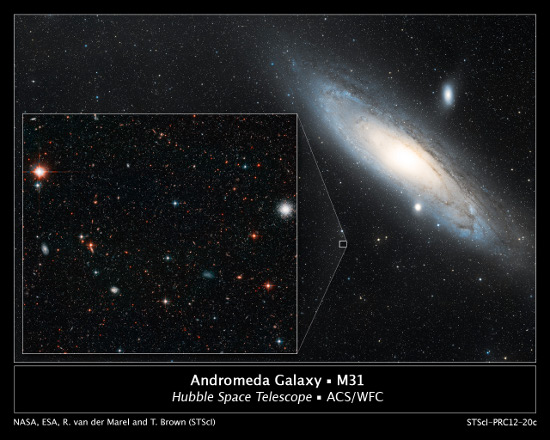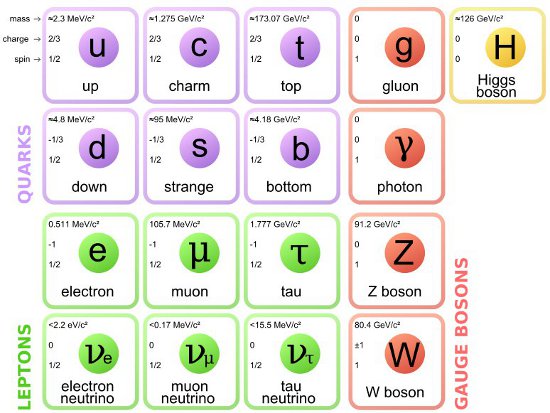What did we know about the size and contents of our universe a hundred years ago? Very little. Even the proton, the nucleus of the simplest atom (hydrogen), was only discovered by Rutherford in 1917–1919. The neutron, the other occupant of the atomic nucleus, had to wait for its discovery until 1932, and the neutrino, the elusive particle that barely interacts with matter, was only discovered in 1956!
The size and structure of the cosmos were also a complete mystery to the astronomers and physicists of the beginning of the twentieth century. In fact, it was only in 1924 when astronomer Edwin Hubble unambiguously confirmed that there are other galaxies beyond our own Milky Way. Figure 1 shows a recent image of the Andromeda galaxy, M31, which was the first galaxy identified as being outside the Milky Way.

Figure 1.
What do we know today about our universe's dimensions and composition? Quite a bit, although much remains to be explored. Here is a concise inventory. While we don't know the precise size of the universe, and it definitely may be infinite, the radius of the observable universe is about 46 billion light-years. One light-year is the distance that light travels in one year -- approximately six trillion miles. For comparison, the distance to the Andromeda galaxy is "only" about 2.5 million light-years. The universe is about 13.8 billion years old. As far as we can tell, the universe is homogeneous (the same everywhere) and isotropic (the same in every direction) on its large scales. It is also geometrically flat. The average energy density in the universe is the equivalent of about 10 grams per cubic centimeter. About 73 percent of this energy density appears to be in the form of a rather mysterious, smooth, "dark energy," which may represent the energy of the physical vacuum. About 23 percent appears to be "dark matter" -- matter that does not shine light, but which can be detected through its gravitational influence. Ordinary ("baryonic") matter constitutes only about 4 percent of the cosmic energy budget. According to the Standard Model of particle physics, there are 12 elementary particles (the most basic constituents of ordinary matter) that have a quantum mechanical spin of half a unit. These include six quarks (that are called: up, down, charm, strange, top, and bottom) and six leptons (electron, electron neutrino, muon, muon neutrino, tau, and tau neutrino). All of these are commonly grouped into three generations, the first of which includes, for instance, the up and down quarks, the electron, and the electron neutrino. In addition to the matter particles, there are force-carrying gauge bosons that include the photon (carrier of electromagnetism) the gluons (carriers of the strong nuclear force), and the W and Z bosons (the carriers of the weak nuclear force). The latest addition to the list of elementary particles is the Higgs boson (discovered in 2012 and tentatively confirmed in 2013), which plays the crucial role of endowing all the other elementary particles (other than the photon and the gluons) with mass. Figure 2 presents the elementary particles of the Standard Model.

Figure 2. Standard Model of Elementary Particles. From: Wikipedia.
Intriguingly, there are theories that predict the existence of additional components to the above inventory, both in terms of contents (on the smallest scales) and structure (on the largest).
In one suggested extension to the Standard Model known as supersymmetry, every particle is supposed to have a yet-undiscovered partner. The leptons and quarks, for instance, would have sleptons and squarks, while the gluons would have gluinos. So far the Large Hadron Collider has not discovered supersymmetric particles, but it might still do so when it returns to operation at full energy.
On the cosmic scale, a more speculative idea is that of the multiverse -- the proposal that our universe is but one member of a huge ensemble of universes. This speculation is based on insights gained from the concept of inflation -- the brief phase of explosive expansion early on in the universe's evolution, and from string theory. Certain otherwise perplexing properties of our universe (such as the value of the density of "dark energy") may find an explanation if such a multiverse exists. String theory also suggests that in addition to the familiar three dimensions of space and one of time, our universe may have six or seven extra spatial dimensions.
To conclude, the last century has been absolutely phenomenal in terms of how much we have learned about our universe, but all signs are that the next one hundred years will be at least as exciting.